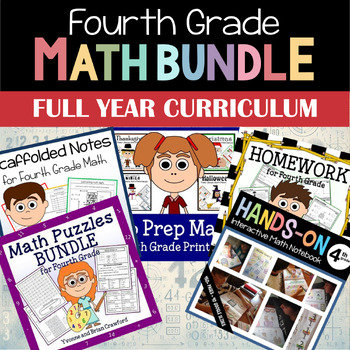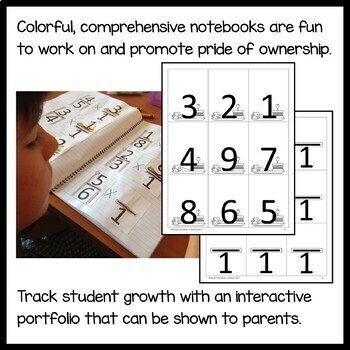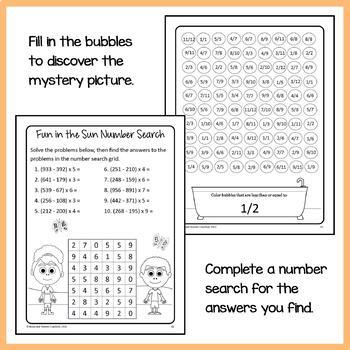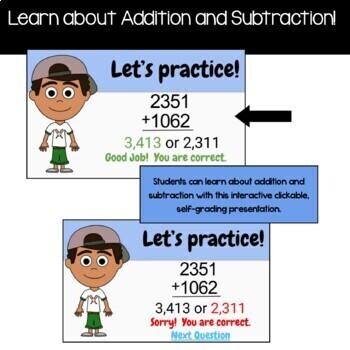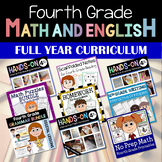4th Grade Math Full Year Curriculum Bundle | Interactive Notebook & More 50% OFF
- Zip
- Easel Activity

Products in this Bundle (167)
showing 1-5 of 167 products
Also included in
- Full Year Curriculum for Fourth Grade including both language arts and math - 4,000 pages - answer keys included!This bundle contains four interactive notebooks for fourth grade, supplying everything you need to keep students engaged in interactive learning for a whole year of English language artsPrice $705.46Original Price $1410.85Save $705.39
Description
4th Grade Math Bundle - Full Year Curriculum including an Interactive Math Notebook for Fourth Grade with Scaffolded Guided Notes + Google Slides, plus so much more, over 2,000 pages!
This huge bundle has everything you need for a full year of teaching 4th grade math:
- A 296-page hands-on interactive math notebook including answer keys
- 125 pages of scaffolded notes including answer keys
- 500+ Google Slides focusing on different math concepts for fourth grade
- 86 pages of interactive printables including answer keys
- 40 Google Slides of the interactive printables for online teaching or distance learning
- 141 pages of homework
- Goofy Glyphs for every holiday
- Color by Number for the entire year
- Math Puzzles for every holiday
- Worksheets for every holiday
- So much more!
Google Slides
2 Google Slides Presentations: One Google Slides Interactive Presentation with 28 to 61 slides that teaches about each topic. These are similar to guided notes or scaffolded notes. One Google Slides Interactive Presentation with 10 slides where students can practice more by moving objects, filling in color, entering answers, and more, all digitally.
· PowerPoint Presentations of same content.
· PDF versions of same content.
· Answer Keys
· PDF file to help you set up the files.
· Free 15 minute zoom meeting if you need any help!
Interactive Notebook
This math notebook is completely hands-on and interactive. Each chapter in this interactive math journal includes a divider for the standard that is covered in the chapter, a hands-on activity for students to put in their math notebooks, and at least one page that you can use as an assessment or as a worksheet for additional skills practice. In addition, each chapter has a page of graphics that your students can color, cut out, and paste into their math notebooks. There are also pictures of children using this notebook to give you and your students ideas about how to set up your own math notebooks.
Scaffolded Notes
Included in this product are 125 pages of scaffolded notes or guided notes and activities. Students will be more engaged in your lessons when they use these notes to help guide their learning. Answer keys are provided as well.
Interactive Printables
These interactive printables can be used as homework, bell work, morning work, sub work, or for skills practice and reinforcement. Great for digital learning! Includes:
- 40 interactive printables
- 40 Google Slides of the interactive printables
- A PDF of instructions for setting up your Google Slides
- Answer keys
All Common Core State Standards (CCSS) for Fourth Grade Mathematics are covered in this book.
Topics covered:
- Multiplication as a Comparison
- Word Problems with Multiplication and Division
- Multi-step Word Problems
- Prime and Composite Numbers
- Creating Patterns
- Place Value
- Reading and Writing Numbers
- Rounding Numbers
- Adding and Subtracting
- Multiplication
- Division
- Equivalent Fractions
- Comparing Fractions
- Adding and Subtracting Fractions
- Multiplying Fractions
- Fractions with Denominators of 10 and 100
- Decimal Notation for Fractions
- Comparing Decimals
- Equivalent Measurements
- Measurement Word Problems
- Areas and Perimeters
- Line Plots for Measurement Data
- Angles
- Measuring Angles
- Adding and Subtracting Angles
- Drawing and Identifying Lines and Angles
- Classifying Figures
- Symmetry
Make sure to look at the preview for more details about this fun and interactive way to teach math in your classroom!
All graphics are originals and created by myself.
Thanks for visiting my store,
Yvonne Crawford

